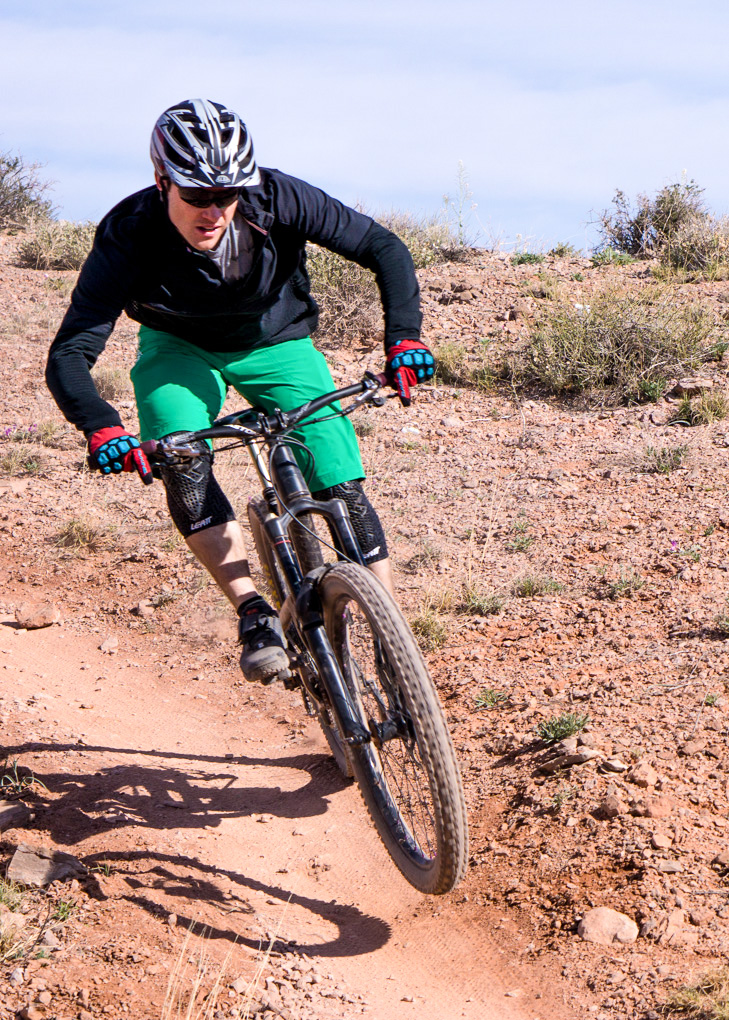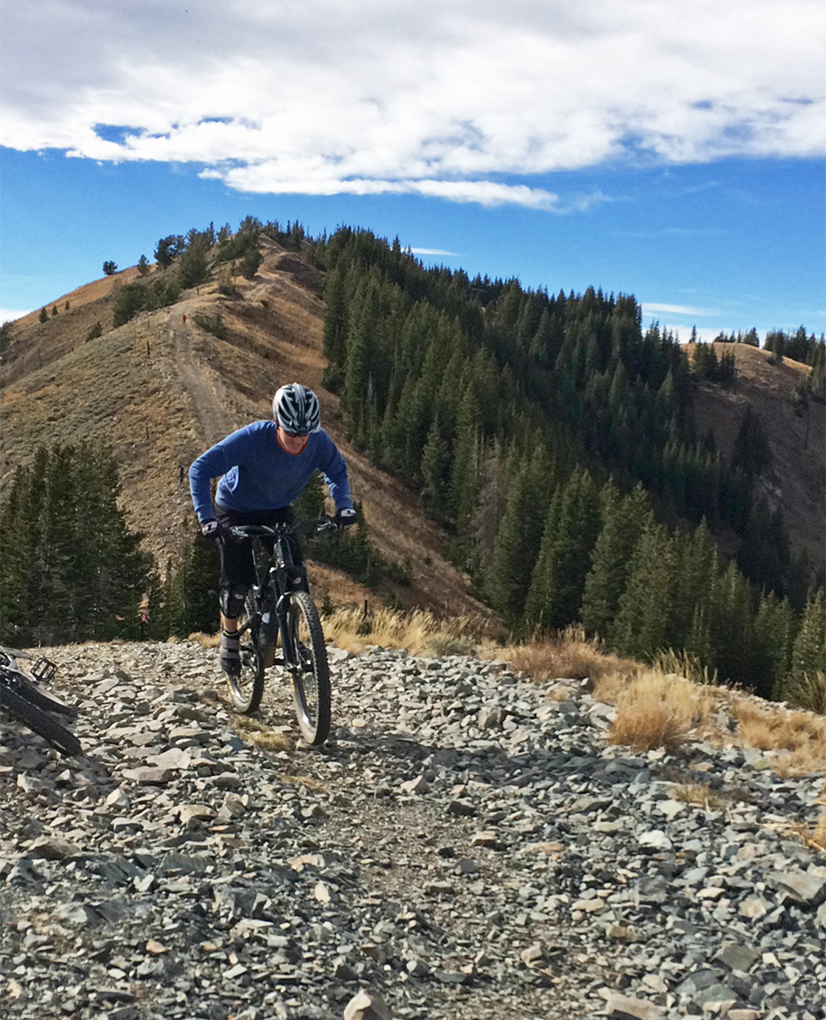My wheels are based around my favorite Hadley hubs. They aren’t the lightest, but they feature great engagement, a titanium freehub body which helps prevent cassettes scarring the hub, and high quality bearings. These are one of my favorite, easy-to-forget items. They work really well in every way a hub should, and are easily reconfigured to fit most axle standards. I only notice them when I hop on other hubs and start longing for the quicker engagement and stiffness that these offer.
I used double butted spokes to lace them to WTB KOM i25 rims (review coming soon). I like the 25mm internal width as it creates a nice tire profile. The double-butted spokes save weight and stay tight a little better than straight gauge spokes because of their compliance. I’m interested to see how the KOM rims hold up. They are quite light—even approaching carbon rim weights—but I tend to ride smoothly … until I’m suddenly not. When I do goof up, I end up denting or cracking just about any rim I’ve ever run.
If these KOM rims (a) hold up while I’m smooth and (b) don’t fail any more catastrophically than anything else when I hit something hard I’ll be very excited about using them instead of carbon rims.

I’m running the Maxxis High Roller II tires, tubeless with Stan’s sealant. I run 28psi in the front and 30psi in the rear. I’ve found this offers a nice balance of grip and tire stability. The High Roller II’s are big meaty tires, and they definitely are slow on climbs. But they let me push the bike in the way its designers intended.
A Shimano XTR M980 drivetrain and brake system handle pedaling and braking. The XTR parts have held up a bit better for me than any lower-level Shimano parts (I attribute that down to nicer materials and manufacturing tolerances), so I feel that the higher price is justified. I use slightly short 170mm cranks because my legs aren’t very long, I prefer to spin instead of crank, and I enjoy the extra ground clearance.
The only non-XTR parts in the drivetrain are the wear items—the cassette and chain. I use XT level cassettes and chains because they are a lot less expensive than the XTR versions, and I go through them with some frequency. The XT level parts are nicer than the SLX items, the cassette offers reasonably significant weight savings, and the chain coating does a better job of resisting rust.
The XTR Trail brakes have a great lever shape, don’t fade significantly, and have held up extremely well. I could stand to have a bit more modulation, but they are pretty good. Overall, I’m quite happy with them.
I like running 1X with a narrow/wide chainring, and have had great luck with the Wolftooth rings. I’m currently reviewing their newest offering with a slightly revised tooth shape that is designed help clear mud (review pending).
I’m testing the Easton Haven 35mm bar/stem combo in my preferred 750mm width. Many people prefer wider bars, but my shoulders are only so broad. I can run 760mm-740mm or so pretty happily, going longer for stability and shorter for quicker handling. The 65 degree headangle works with the 750mm bars for slightly quicker handling. I’m using a 40mm stem instead of 55mm. I like the position this puts me in for descents.
Bolted to the KS dropper post is a SQ Labs 611 active saddle. It is the right width for my sit bones, and I was curious if the elastomers that permit a bit of rocking motion would make for a more comfortable ride. I’m not sure that I can tell, but the seat has been comfortable. Its fit is similar to the WTB Silverado.
I have had reasonably good luck with KS dropper posts, so one found its way onto this bike. I can’t run a 150mm dropper because my legs are short, so I run the 125mm version.

I prefer to run grips without locks. With an air compressor they are easy to install and remove, and the lack of an internal plastic sleeve means that they offer a lot more cushion/vibration damping for a given diameter. I change grips at least once a year, and I like to try a variety of styles.
After riding the bike for a while, I found it a bit hard to get the front tire to bite at low speeds on flatter trails. I ordered a set of offset bushings for the Monarch shock to bring the headangle to ~66 degrees. I now run that shock in the early and late season when I am on flatter and lower elevation trails. I swap it out for an Avalanche Chubie to handle steeper descents. The Monarch is outstanding, but the Chubie is still a bit better in really rough situations.
I started with the stock Rock Shox Pike RCT3 fork and Monarch Plus RC3 Debonair shock. They felt great, but were a little less planted than I wanted on really rough trails, so I had my Avalanche dampers from the previous Nomad modified to fit the Pike and the new frame.
The AVA cartridge remains in the fork at all times, partly because swapping fork cartridges is a pain, and partly because the Avalanche fork has similar small bump sensitivity and much better performance in really rough terrain and at high speeds. The damper is very speed sensitive and does a great job of handling varied terrain. I like the lively feel of the Charger damper, but I felt that it didn’t feel quite as planted as the Avalanche damper.
Pretty much every part on my bike was chosen to be durable. The only downside I’ve found is that the bike is a bit too capable. It makes moderately challenging trails really easy, and only gets a little flustered on really hard trails. There just aren’t that many really technical trails out here, so I’m considering adding a bike like Noah’s Canfield Yelli Screamy to the quiver to make things more interesting on the smoother trails.
The Nomad does climb quite well, and is surprisingly nimble given its long wheelbase. So it is still fun on mellower trails, but it feels a bit like a German Autobahn car does on American highways. I’m sure sizing up plays a factor in making the bike more stable at speed, but I would rather step down to something with less travel than to a shorter, smaller-sized bike, as the geometry of my Large Nomad feels great.

Awesome setup Tom! Would love a separate review of the Avalanche damper in your Pike. Thinking of getting one.
Thanks Matt. We might do a separate review in the future. To help you with the immediate decision, the biggest difference with the AVA cartridge is mid-stroke support. The Charger damper is great, but I wasn’t thrilled with how it performed when I increased the low speed compression to handle really chunky terrain. The AVA doesn’t have the light and playful feeling that the Charger lends itself too, but offers a ton of support through rough terrain and is still very smooth over small bumps. Both are great, but they are definitely different.
New England trail rider here. Can you comment on what bike you’d be riding today if you still lived and rode in New Hampshire? Would the new Nomad be too long and stack for the tight technical trails?
John, I wouldn’t be on a Large Nomad in New Hampshire unless I were spending a lot of time riding lifts. The bike just requires too much speed before it becomes fun. I would struggle to keep it up at that speed on the flatter trails in New England. Staying within the Santa Cruz family for easy comparisons, I’d be on a Medium Nomad if I still wanted a lot of travel. A Large 5010 if I prioritized a comfortable riding position but wanted a more playful bike, and a Medium 5010 if I prioritized fun and flickability at the cost of feeling a bit cramped on the bike. I’d also try out some of the offerings from Devinci, Norco, and Specialized if I were looking for something similar, but with a different suspension design. There a ton of other great options out there too, but those happen to be at the fore of my mind at the moment.
Great detailed review! You must check out the Canfield Brothers EPO.
Thanks Ray! The EPO is certainly on my radar!